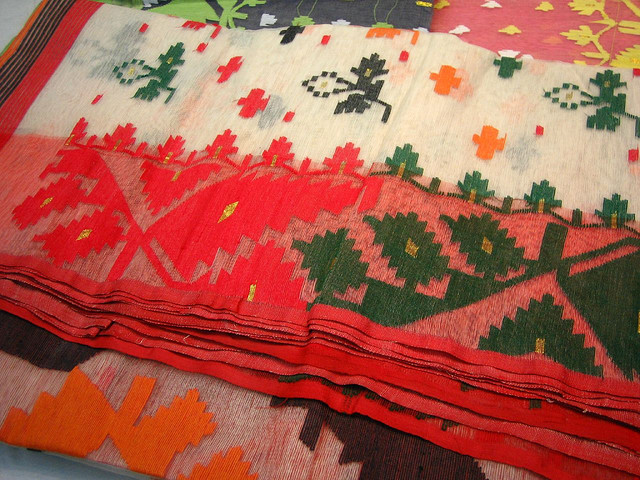Jamdani Saris are the traditional saris of Bengal. The art of weaving Jamdani evolved in Dhaka in Bangladesh (former East Bengal of undivided Indian) and Dhakai Jamdanis was famous among the women of the royal families.
After the partition of India, the centers of Jamdani sari weaving shifted to the looms of West Bengal. The villages of Shantipur, Dhaniakhali, Begampur and Farasdanga are famous for cotton hand loom saris or tant saris.
The materials chosen for weaving Jamdani saris are cotton, muslin or muga silk. These materials are very comfortable to be worn in the hot tropical climates of India, especially during the summer months. The popular background colors of the Jamdani saris are white, maroon, black, green, gold and silver. The designs are based on geometrical patterns with the butis or tiny dots or geometrical motifs spread all over the body of the sari. In Jamdani sari weaving technique the weaver inserts the embroidery thread after two ground picks, which differentiates it from other handloom sari weaving techniques of Bengal. The anchals or pallus are the most gorgeously designed portion of the saris.
Fabric in Jamdani Saree: Jamdani is an ancient finely woven cotton fabric called muslin with geometric or floral designs. Jamdani sarees are in cotton, pure silk and tussar silk.
Colour: While the original Bangladeshi sari is almost invariably on a beige background, the Indian weavers are a little more adventurous in their choice of color schemes. A very classy look pervades in the traditional colour.
Various types of Jamdani Sarees :
Daccai Jamdani : Daccai Jamdani sarees are distint from other varieties by its very fine texture resembling muslin and the elaborate and ornate workmanship. These sarees have multicolored linear or floral motifs all over the body and border and have an exquisitely designed elaborate pallu. The mango motif signifying fertility, growth, and marital bliss is a very popular design in Jamdani sarees.
Tangail Jamdani : These sarees have Jamdani motifs on Tangail fabric and hence known as Tangail Jamdani. The traditional tangail borders had a "paddo" or lotus pattern, "pradeep' or lamp pattern, apart from the popular "aansh paar' which was common to Shantipur. From the use of a single colour on the border, they began to use 2 to three colours to give it 'meenakari' effect.
Shantipur Jamdani : This variety of sarees have a powder fine texture.
Dhaniakhali Jamdani : Having a tighter weave than the "tangail" or "shantipur", Dhaniakhali Jamdani is more hardy. Its bold body colours and contrasting borders and absurdly low prices make them very affordable.

